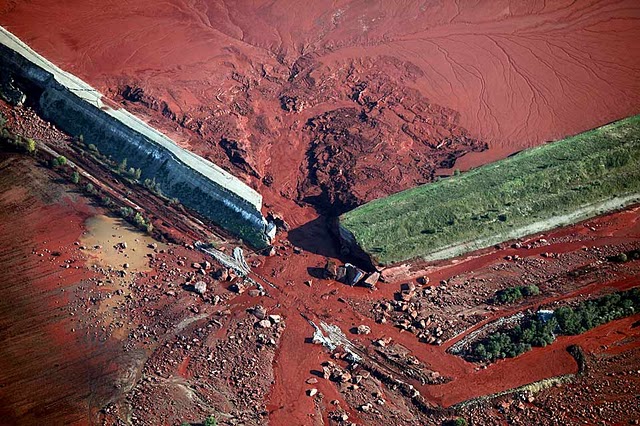19 December 2010
The outcome of a study of the Kolontar Tailings Dam failure
Posted by Dave Petley
Regular readers will remember that I covered in a number of posts the tailings dam failure at Kolontar in Hungary, which flooded a town with bauxite waste with fatal consequences. At the time we tried to “crowd source” an interpretation of what had happened, and as a result we speculated that the failure might have resulted from a foundation failure of the dam caused by high pore pressures, which led to the dam lifting off its foundations, generating a rupture at the corner of the structure where the stresses were concentrated (image from Greenpeace):
Thanks to Caner Zanbak, Environmental Advisor to the Turkish Chemical Manufacturers Association, for making available a pdf of a presentation outlining the results of an investigation that he undertook of the failure. The presentation can be downloaded as a zip file below – note that the file contains only the pdf:
Caner has indicated in his presentation that the information in the presentation can be reproduced with acknowledgement. So what did he find?
Well, first the dam is built from fly ash, which behaves like a low quality concrete. Second, was constructed without proper foundations or a permeability barrier. Third, it notes, as we did here, that there were clear signs of seepage from beneath the dam in images taken in June 2010. Thus the author concludes that
“The dike failure was probably:
• Triggered by a shear failure in the dike at the seepage point located about 300 metres east of the northwestern corner of the impoundment, due to increased pore water pressures;
• Caused by separation of the north dike at the northwestern corner of the impoundment, and tensile fracturing in the easterly-displaced north dike segment; and
• was propagated by incremental eastern movement of the dike segment (west of the shear zone) where the fractured blocks in the northwestern corner of the dike were pushed out by the water in the impoundment causing the ultimate structural failure.”
The presentation finishes with a “moral of the story: “No leak/seepage is insignificant for retaining structures”, Good advice.
Thanks again to Caner for making this available. It not only helped with the understanding of this event, it also gave me something to look at whilst I kill the three days wait for my flight, thanks to the cancelation of my journey yesterday due to the snow in London.



 Dave Petley is the Vice-Chancellor of the University of Hull in the United Kingdom. His blog provides commentary and analysis of landslide events occurring worldwide, including the landslides themselves, latest research, and conferences and meetings.
Dave Petley is the Vice-Chancellor of the University of Hull in the United Kingdom. His blog provides commentary and analysis of landslide events occurring worldwide, including the landslides themselves, latest research, and conferences and meetings.
Thanks so much for posting this follow-up Dave. I read the presentation with much interest; I’d been wondering what the findings would be.
[…] dam failure in Hunan in 2009. The most spectacular tailings dam failure recently was that of the Kolontar bauxite mine in Hungary last year which sent a river of toxic red sludge into the […]